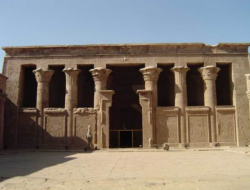 Grade I (GI) listed Temple Works flax mill, which once boasted the biggest room in the world, had been put up for auction with no reserve after years of neglect, leading to local accusations of a ‘washing of hands’ of heritage responsibilities by the billionaire owners of the Telegraph, the Barclay brothers, but now Leeds property developer CEG has agreed to buy the building the day before it was due to sold at auction in a last-minute deal welcomed by Leeds City Council and Leeds Civic Trust.
Grade I (GI) listed Temple Works flax mill, which once boasted the biggest room in the world, had been put up for auction with no reserve after years of neglect, leading to local accusations of a ‘washing of hands’ of heritage responsibilities by the billionaire owners of the Telegraph, the Barclay brothers, but now Leeds property developer CEG has agreed to buy the building the day before it was due to sold at auction in a last-minute deal welcomed by Leeds City Council and Leeds Civic Trust.
image Leeds Civic Trust
CEG Development director Jon Kenny said: ‘We are pleased to become the custodian of an important element of the city’s historic culture and look forward to working with Leeds City Council to progress the regeneration of this challenging site.’
The Guardian reports (in 27 November, before the final deal was struck):
The billionaire owners of the Telegraph have been accused of ‘washing their hands’ of one of the UK’s most important and unusual industrial buildings after leaving it to rot for more than a decade and then putting it up for auction for a pound.
Temple Works is a Grade I-listed former flax mill in Leeds which boasts a 0.8 hectare (2 acre) factory floor which was once the largest room in the world. It also saw the installation of the first ever hydraulic lift, used to transport sheep up to the roof for grazing. The sheep were part of a revolutionary rainwater collection system used to make steam to spin flax into yarn. The building, once described by the Yorkshire Post as looking ‘like a stately home for a pharaoh’, has been owned since 2004 by the secre
tive Barclay family, who bought the Telegraph media group in 2004.
Built in 1836, it was modelled on the Temple of Horus at Edfu, on the banks of the Nile, reflecting the interest in Egyptology of John Marshall, the founder of the Leeds flax industry. According to Historic England, the building represents the zenith of the Marshall Mills flax business in Leeds and had acquired a legendary reputation within a few years of its construction. The Egyptian facade, featuring elaborate giant columns topped with lotus capitals and hieroglyphic-filled coving, was designed by the Egyptologist Joseph Bonomi, brother of the architect Ignatius Bonomi. Egypt had an important flax industry in the ancient world.
Martin Hamilton, the director of Leeds Civic Trust said: ‘We are disappointed that the owners have chosen to dispose of the building by auction. It feels like they are washing their hands of what they must see as a liability. There is now a real risk that a naive investor will purchase the building without the resources to spend on refurbishment – possibly upwards of £20m, leading to more years of neglect, planning and legal wrangles and quite possibly the final nail in the coffin for this building. We would appeal to the owners to withdraw the building from the auction and to work with Leeds city council and other interested parties to identify a buyer with the necessary resources to turn the building round, and a use that would be a focus for the wider regeneration of this part of Leeds city centre.’
The council has bought several acres of land around the site which it could offer the right buyer of Temple Works as a sweetener. By 2033, the HS2 railway station should have been built a short walk away.
Martin Farrington, the director of city development, said: ‘Temple Works is a very significant part of the industrial heritage not just of Leeds but also the UK and the council will work collaboratively with an experienced developer who wants to bring the building back into sustainable use.’
For more on the issue see Leeds Civic Trust and for the current situation see BBC News

